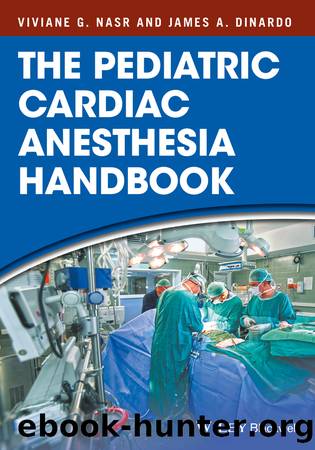The Pediatric Cardiac Anesthesia Handbook by Viviane G. Nasr & James A. DiNardo

Author:Viviane G. Nasr & James A. DiNardo [Nasr, Viviane G. & DiNardo, James A.]
Language: eng
Format: epub
Published: 2017-05-01T00:00:00+00:00
Hypoxic or Hypercyanotic Episodes (‘Tet Spells’)
The occurrence of hypoxic episodes in TOF patients may be life‐threatening and should be anticipated in every patient, even those who are not normally cyanotic. Spells occur more frequently in cyanotic patients, with the peak frequency of spells between 2 and 3 months of age. The onset of spells usually prompts urgent surgical intervention, so it is not unusual for the anesthesiologist to care for an infant who is at great risk for spells during the preoperative period.
The etiology of spells is not completely understood, but infundibular spasm or constriction may play a role. Crying, defecation, feeding, fever, and awakening all can be precipitating events. Paroxysmal hyperpnea is the initial finding. There is an increase in the rate and depth of respiration, leading to increasing cyanosis and potential syncope, convulsions, or death. During a spell, the infant will appear pale and limp secondary to poor cardiac output. Hyperpnea has several deleterious effects in maintaining and worsening a hypoxic spell. Hyperpnea increases oxygen consumption through the increased work of breathing. Hypoxia induces a decrease in systemic vascular resistance (SVR), which further increases the R‐L shunt. Hyperpnea also lowers intrathoracic pressure and leads to an increase in systemic venous return. In the face of infundibular obstruction, this results in an increased right ventricular preload and an increase in the R‐L shunt. Thus, episodes seem to be associated with events that increase oxygen demand while simultaneous decreases in PO2 and increases in pH and PaCO2 are occurring. Under anesthesia, ‘Tet spells’ will be heralded by a subtle, progressive decrease in end‐tidal CO2 (ETCO2) that precedes a detectable decrease in SaO2. Cardiac output will be maintained in this setting by the delivery of venous blood from the right ventricle to the aorta across the VSD.
The treatment of a ‘Tet spell’ includes:
The administration of 100% oxygen.
Compression of the femoral arteries or placing the patient in a knee‐chest position which transiently increases SVR and reduces the R‐L shunt. Manual compression of the abdominal aorta or compression of the ascending aorta if the chest is open to increase impedance to ejection through the left ventricle.
Administration of morphine sulfate (0.05–0.1 mg kg–1), which sedates the patient and may have a depressant effect on respiratory drive and hyperpnea.
Administration of 15–30 ml kg–1 of a crystalloid solution. An enhancing preload will increase the heart size, which may increase the diameter of the RVOT.
Administration of sodium bicarbonate to treat the severe metabolic acidosis that occurs during a spell. Correction of the metabolic acidosis will normalize the SVR and reduce hyperpnea. Bicarbonate administration (1–2 mEq kg–1) in the absence of a blood gas determination is warranted during a spell.
Phenylephrine in relatively large doses (5–10 μg kg–1 intravenous as a bolus or 2–5 μg kg–1 min–1 as an infusion) increases SVR and reduces R‐L shunting. In the presence of severe right ventricular outflow obstruction, phenylephrine‐induced increases of pulmonary vascular resistance (PVR) will have little or no effect on increasing right ventricular outflow resistance. It is important to point out that treatment with α‐adrenergic agents to increase the SVR
Download
This site does not store any files on its server. We only index and link to content provided by other sites. Please contact the content providers to delete copyright contents if any and email us, we'll remove relevant links or contents immediately.
| Anesthesiology | Colon & Rectal |
| General Surgery | Laparoscopic & Robotic |
| Neurosurgery | Ophthalmology |
| Oral & Maxillofacial | Orthopedics |
| Otolaryngology | Plastic |
| Thoracic & Vascular | Transplants |
| Trauma |
When Breath Becomes Air by Paul Kalanithi(7264)
Why We Sleep: Unlocking the Power of Sleep and Dreams by Matthew Walker(5641)
Paper Towns by Green John(4169)
The Immortal Life of Henrietta Lacks by Rebecca Skloot(3826)
The Sports Rules Book by Human Kinetics(3588)
Dynamic Alignment Through Imagery by Eric Franklin(3489)
ACSM's Complete Guide to Fitness & Health by ACSM(3468)
Kaplan MCAT Organic Chemistry Review: Created for MCAT 2015 (Kaplan Test Prep) by Kaplan(3423)
Introduction to Kinesiology by Shirl J. Hoffman(3300)
Livewired by David Eagleman(3122)
The River of Consciousness by Oliver Sacks(2992)
Alchemy and Alchemists by C. J. S. Thompson(2911)
The Death of the Heart by Elizabeth Bowen(2901)
Descartes' Error by Antonio Damasio(2731)
Bad Pharma by Ben Goldacre(2730)
Kaplan MCAT Behavioral Sciences Review: Created for MCAT 2015 (Kaplan Test Prep) by Kaplan(2492)
The Gene: An Intimate History by Siddhartha Mukherjee(2491)
The Fate of Rome: Climate, Disease, and the End of an Empire (The Princeton History of the Ancient World) by Kyle Harper(2436)
The Emperor of All Maladies: A Biography of Cancer by Siddhartha Mukherjee(2431)
